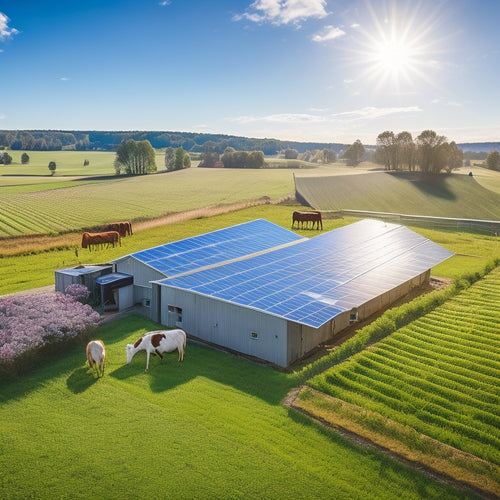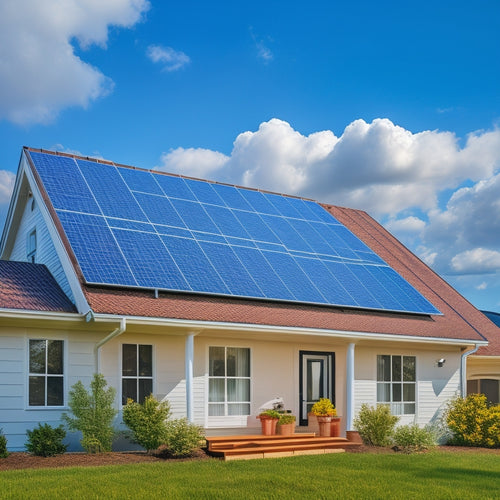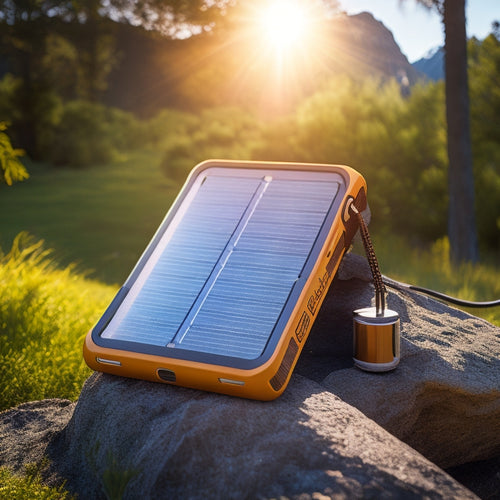
Asphalt Roof Solar Panel Mounting Solutions
Share
When installing solar panels on an asphalt roof, you need a mounting solution that can securely fasten the panels while preserving the integrity of the roof's shingles, a delicate balance that requires careful consideration of factors such as load calculations, waterproofing, and code compliance. You'll want to investigate the three primary mounting options - rail-based, rail-less, and shared-rail systems - and consider durable solutions like IronRidge and Unirac for reliability. By understanding the unique challenges of asphalt roofs and the importance of secure fastening, you'll be well on your way to finding the ideal mounting solution that meets your needs and guarantees a safe, efficient, and long-lasting installation.
Overview
- Secure fastening of solar panels is crucial to prevent damage to asphalt shingles, ensuring a reliable and durable installation.
- Three primary mounting options for asphalt roofs include rail-based, rail-less, and shared-rail systems, each with its own benefits and challenges.
- Racking materials must withstand extreme temperatures, winds, and snow loads, with load calculations necessary to support solar panel weight and additional loads.
- A watertight seal between the roof surface and racking system is critical, achieved through effective flashing techniques and waterproof membrane application.
- Compliance with local building codes and regulations, such as UL 2703 and IEEE 1547 standards, is essential for a safe and efficient solar panel installation.
Asphalt Roof Solar Panel Installation
Across the United States, numerous homeowners opt for asphalt roofs due to their affordability, durability, and ease of installation.
When you decide to install solar panels on your asphalt roof, you'll face unique installation challenges. You'll need to verify the solar panels are securely fastened to the roof without damaging the asphalt shingles or compromising their waterproofing.
Aesthetic considerations are also essential, as you'll want the solar panels to blend in with the roof's appearance. For instance, durable panel mounting solutions like IronRidge and Unirac can provide a secure and reliable installation.
You'll need to choose a mounting system that complements the roof's design and color scheme. By carefully planning and executing the installation, you can overcome these challenges and enjoy the benefits of solar energy while maintaining your roof's integrity.
Mounting Options for Asphalt Shingles
When installing solar panels on an asphalt roof, you'll typically encounter three primary mounting options for attaching the panels to the asphalt shingles: rail-based, rail-less, and shared-rail systems.
Each mounting technique presents unique installation challenges. When selecting a mounting system, it's crucial to take into account factors such as durability, ease of installation, and ideal panel angles, as well as ensuring compatibility with various solar panel brands and sizes exceptional durability.
Rail-based systems require more hardware, increasing material costs and labor time. Rail-less systems, on the other hand, use fewer components, reducing installation time and costs, but may not be as secure in high-wind areas.
Shared-rail systems offer a balance between the two, providing a sturdy attachment while minimizing material usage. Choosing the right mounting option depends on factors such as roof size, panel layout, and local building codes.
Solar Panel Racking Systems Design
Designing solar panel racking systems requires careful evaluation of multiple factors to guarantee a secure and efficient installation.
You'll need to select racking materials that can withstand various environmental conditions, including extreme temperatures, high winds, and heavy snow loads. Load calculations are essential to confirm that the racking system can support the weight of the solar panels, as well as any additional weight from snow or debris.
In remote areas, corrosion resistance is important to maintain efficiency, and proactive planning can help mitigate maintenance challenges.
You'll also need to take into account the roof's structural integrity, reflecting on factors like roof pitch, size, and material.
Flashing and Waterproofing Solutions
Your solar panel installation's longevity and performance rely heavily on a watertight seal between the roof's surface and the racking system.
To achieve this, you'll need to employ effective flashing techniques that guarantee a secure connection between the two. This typically involves applying a waterproof membrane around the mounting points, followed by a layer of flashing material.
The membrane prevents water from seeping into the roof, while the flashing material directs water away from the mounting points.
By using high-quality materials and adhering to established flashing techniques, you can guarantee a watertight seal that protects your solar panel installation from the elements.
This, in turn, helps maintain the system's performance and extends its lifespan.
Code Compliance and Certification
With a watertight seal in place, you can now focus on ensuring your asphalt roof solar panel mounting solution meets local building codes and regulations. This involves obtaining the necessary certifications and adhering to installation standards. Familiarize yourself with the relevant codes and regulations in your area, such as the International Building Code (IBC) and the International Residential Code (IRC).
| Code/Standard | Description |
|---|---|
| IBC | International Building Code, governing commercial and industrial buildings |
| IRC | International Residential Code, governing residential buildings |
| UL 2703 | Standard for Mounting Systems, Mounting Devices, Clamping Devices, and Ground Lugs for Use with Flat-Plate Photovoltaic Modules and Panels |
| IEEE 1547 | Standard for Interconnecting Distributed Resources with Electric Power Systems |
Frequently Asked Questions
Can Solar Panels Be Installed on Asphalt Roofs With Skylights or Vents?
You'll need to contemplate skylight considerations and vent placement when installing solar panels on a roof with these features, ensuring a secure and watertight seal around obstructions to maintain your roof's integrity and maximize energy production.
How Do Solar Panels Affect Asphalt Roof Warranties or Insurance?
When you install solar panels, you'll need to take into account warranty implications and insurance considerations, as they may impact your roof's coverage; it's vital to review and understand the terms to guarantee you're not voiding your warranty or affecting your insurance premiums.
Are There Any Local Incentives for Asphalt Roof Solar Installations?
You'll find local incentives for solar installations, such as tax credits and installation rebates, that can offset costs; research your area's policies to maximize savings, as these incentives vary by region and provider, giving you more freedom to go solar.
Can I Install Solar Panels on an Asphalt Roof Myself?
You're a trailblazer, taking the reins of your solar expedition, but before diving into a DIY installation, you'll need to saddle up with serious safety precautions, including proper ladder use and electrical know-how, to avoid a hazardous ride.
How Do I Clean Snow off Solar Panels on an Asphalt Roof?
You'll maintain peak solar panel efficiency by using gentle snow removal techniques, such as soft-bristled brushes or snow rakes, to clear snow without scratching the panels, ensuring uninterrupted energy production and freedom from grid dependence.
Ready to Buy
As you prepare to utilize the power of solar energy, you're about to set off on a critical phase: securing your panels to an asphalt roof. The fate of your investment hangs in the balance. Will your mounting system withstand the forces of nature? Will your flashing and waterproofing solutions keep the elements at bay? The clock is ticking. Code compliance and certification await. Your asphalt roof solar panel mounting solution is just the beginning of an expedition that will leave you energized - or exhausted.
Related Posts
-

What Do I Need to Know About Farm Solar Panels
When considering farm solar panels, you need to assess costs, benefits, and technical specifics. Initial investment c...
-

Cost of Solar Panel Installation
You can expect to pay between $15,000 and $30,000 or more for a typical solar panel installation, depending on the sy...
-

Fastest Solar Chargers for Emergency Power
When choosing the fastest solar chargers for emergency power, you need to focus on features like rapid charging capab...


